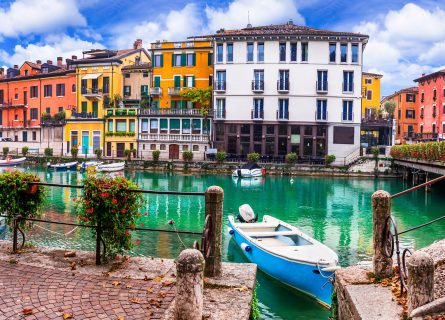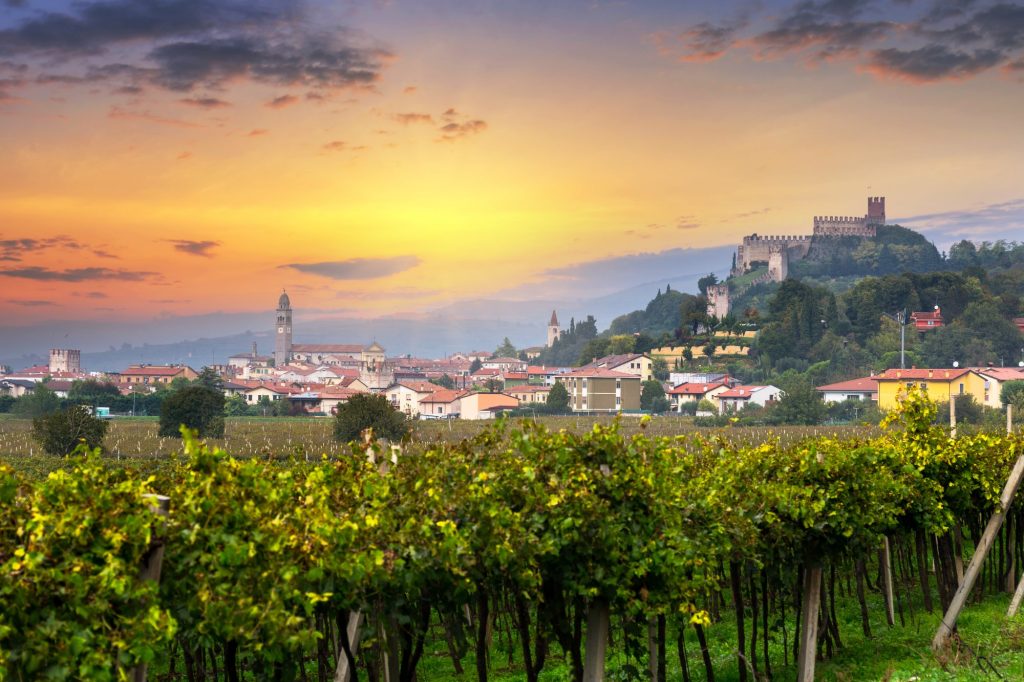
Lake Garda’s Liquid Luxury: Lugana’s Elegant Whites
August 2, 2025
Explore the exquisite flavors of Lugana white wines from Italy's stunning Lake Garda region and discover its unique characteristics.
By: Sara Porro / Last updated: October 2, 2025
When I first began writing travel stories for the Italian press, I often fell back on a kind of provincial reflex. To pitch a destination, I would cite the authority of others: maybe the New York Times had just named it among the “25 Places to Visit This Year,” or Condé Nast Traveler had placed it on its “Hot List.” It was a shortcut that worked, until one editor pointed out that quoting another magazine’s picks was… not much of a story in itself. He was right—obviously. Why should it have taken a prestigious American newspaper to make me notice a corner of Italy? And yet, it was precisely this sort of “inferiority complex” that pushed me to start appreciating—and eventually championing— the Soave region.

It all started in 2009, when Eric Asimov published an article in the New York Times titled “A Touch of Chablis in Italy”. In it, he compared three bottles, two Chablis and one Soave from Pieropan, and wrote: “A good Soave has a lot in common with a good Chablis. It is clear they come from the same family of wines that, despite vintage variations, emphasize earth and stone rather than fruits.”
Ah, the irony! My epiphany had come with a double helping of provincialism. Not only did I need the New York Times to tell me Soave was worth noticing, I also required the comforting stamp of approval that came from comparing it to a great French white. And yet, that line put into words what I had long felt but had never quite managed to articulate: my own leaning away from easy fruitiness and toward wines that taste of stone and salt. From that moment, Soave stopped being just another anonymous Veneto white (Pinot Grigio, anyone?) and started feeling like a wine I actually wanted to know better.
To understand how Soave’s reputation evolved, it helps to look back at its history. Soave became an official wine zone in the early twentieth century—among the earliest Italian whites to receive formal delimitation—and the boundaries of the Soave Classico area have remained unchanged ever since. The DOC was created in 1968, then rode the wave of postwar expansion, pushing plantings down from the historic hills into the fertile plains (a history that would soon repeat itself with Prosecco). Volumes soared, quality fell, and the name Soave became synonymous with neutral, “watery” wine.
With wine consumption declining and Italy already oversupplied with vineyard land, Soave could no longer rely on volume. The answer was to go back to what had always set the region apart: its hills. Producers returned to these slopes, where poorer soils and lower yields naturally gave more distinctive wines. They began mapping terroirs and bottling single sites. Annual production remains around 30 million bottles, yet only about 12 million come from the Classico zone, where the most characterful wines are produced.
UGAs & “Vigna” on the Label
Apart from a few true obsessive wine geeks, soil talk is not usually the most gripping part of wine. But in this region—pardon the cliché—history truly comes alive. Soave’s vineyards are situated on two distinct types of hills: the volcanic slopes, dark with basalt, yield wines that are tense and salty, with flavors that often recall smoke and stone. The limestone hills to the west tend to produce wines that are rounder and more perfumed: under the vines was once a tropical seabed, and the proof is still on display: at the museums in Roncà and Bolca, you can see shells, insects, brilliantly colored fish, even a small crocodile, all fossilized in stone.
It is the same geology that now anchors Garganega’s roots, turning ancient oceans and volcanic eruptions into flavors of salt, smoke, and stone. Together, these marine sediments and volcanic rocks give Soave a dual personality—tense and saline from basalt, round and perfumed from limestone.
In the vineyards themselves, training methods reflect both tradition and the changing climate. The old ‘pergola veronese’, with vines trained high and leaves forming a canopy, was once a way to manage big crops. Today, it also serves as a shield against the brutal summer sun, keeping grapes cool and preserving acidity in a warming climate. Newer plantings often use guyot or spur cordon, which give smaller harvests and fruit with a different balance.
In the cellars, most producers keep things restrained: stainless steel tanks or large neutral casks, little or no new oak, and time on the lees to add texture. Skin contact is rare, used only by a few estates.
With the return to quality and focus on terroir in recent years, Soave has experienced what some of the most influential voices in international wine writing have called a “Soave renaissance.” At the center of that revival stand three producers in particular: Pieropan, Inama, and Suavia.
Pieropan: Leonildo Pieropan, a country doctor in Soave, initiated winegrowing activities in 1901 by purchasing the vineyard known as Calvarino. In 1966, his grandson, another Leonildo, after graduating in enology and viticulture from the Conegliano school, acquired new vineyards in the most suitable areas, introduced new technologies, and traveled widely. In just a few years, he became a leading interpreter of Soave and a recognized authority both nationally and internationally.
His idea was simple but forward-looking for Italy at the time: to highlight single vineyards. The concept of cru was well established in France and was starting to appear in the Langhe, but bringing it to Soave in the early 1970s helped set a new direction for Italian white wine. This led to two symbolic wines of Italian enology: Vigneto Calvarino in 1971, the first white cru in Italy, and Vigneto La Rocca in 1978. Calvarino, on volcanic basalt, is the most authentic and long-lived expression of Soave; La Rocca, situated on calcareous soils beneath the Scaliger castle, enjoys a unique microclimate that produces a distinct bouquet and taste profile.
Inama: Giuseppe Inama began acquiring parcels on Monte Foscarino in the 1960s, convinced its basaltic slopes could yield greatness. Today, the estate is best known for two crus that show just how different Soave can be from one hill to the next. Vigneti di Foscarino is crafted from old vines on volcanic soils and opens with notes of field flowers – including elderflower, iris, and chamomile – before deepening into almond and pollen as it ages. Carbonare, by contrast, is a high, cooler vineyard that delivers piercing minerality and a fresher, more vertical profile.
On the label, twin heads – adapted from drawings by the English architect Inigo Jones – make the wine highly recognizable. They mirror the dual nature of wine itself: sacred and meditative on one side, profane and bacchanalian on the other.
Suavia: The Tessari family has lived and farmed the hills of Fittà since the 1800s, a small hamlet in the Soave Classico zone. The winery itself is relatively young, having been founded in 1982, when Giovanni Tessari and Rosetta Buratto decided to vinify their own grapes rather than sell them. Today, their daughters Meri, Valentina, and Alessandra run the estate, carrying on the tradition from the same village where it all began. The name Suavia recalls the medieval name of Soave, when the castle still dominated the town and its surrounding vineyards.
Their flagship wine is Monte Carbonare, from black volcanic soils so stark that the family says drinking it is like “having a piece of earth in the glass.” The vines here plunge their roots into pure basalt, giving a wine that is sharp and forthright, with cutting minerality and smoky edges.
Soave today falls broadly into two tracks. At one end are crisp, floral whites for immediate pleasure, often bottled as Soave Classico. At the other are hillside and UGA wines, denser and more savory, with a mineral core that rewards patience. Top bottlings can age five to ten years, gaining depth without losing freshness.
Look for Soave Classico, plus a UGA name on the label, and ‘Vigna’ if it is a true single-vineyard wine. By law, the blend must be at least 70 percent Garganega, with Trebbiano di Soave or Chardonnay sometimes included in the mix. Many flagship bottles cost €25–35, a superb price for serious terroir-driven whites.
Serve Soave cool, around 10–12°C. It pairs well with seafood crudo, shellfish, asparagus, and risotto, as well as alpine cheeses or grilled lake fish. The richer single-vineyard wines can even work with poultry or creamy sauces.
Back in 2009, Eric Asimov ended his piece by admitting,
“In the end I was surprised how much I liked the Soave. But I really shouldn’t have been.”
Fifteen years on, surprise is no longer the emotion Soave evokes in a wine lover. What defines Soave today is consolidation: a denomination that has moved past stereotypes, anchored itself in its hills, and shown the world another fascinating example of the great Italian indigenous grape varieties.
If you would like us to customize an exclusive luxury tour, contact us and let us know your travel plans. We offer luxury food and wine tours for private groups of a mininium two guests. In addition, all of our private, chauffeured tours are available year-round upon request.

